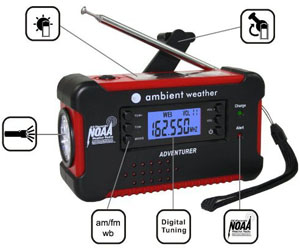Unexpected weather changes can happen at any time, so it’s a good idea to have access to up-to-date weather information. An excellent radio that tunes into the NOAA’s National Weather Service is the Ambient Weather WR-122. The WR-112 features: rechargeable battery, hand crank generator, solar power, flashlight, phone/electronic device charger, SOS flashing beacon and siren. Also uses 3 x AAA batteries as an emergency backup.

OK BUT NOT IDEAL NOAA RADIO; SOLAR AND CRANK ARE MORE MARKETING THAN FUNCTIONAL I live in Hurricane and tornado country near the Coast, so I’m a strong believer in Emergency Preparedness –which means having good, reliable gear for blackouts and power outages.This little compact AM/FM NOAA Weather Radio has both Pro’s and Con’s. I give it 6 to 7 on a 10 scale.”Ambient Weather” is a made-in-China brand. They sell a wide range of models that vary from ‘pretty good’ to ‘cheap junk’. This WR-112 is right in the middle. Certainly better than no radio, but not the ideal choice. This is OK for short indoor power outages but not for wilderness use or Serious Preparedness.At $50 I’d say it’s overpriced and you can do better for the money; but when the price fluctuates around $25 it’s not a bad item to pick up if you don’t already have a better model. There are PLENTY of good radios offering AM/FM/NOAA for $20-$25.Before we get into the Pro’s and Con’s of this radio, I want to also suggest you compare this to other units I believe are…
Very nice radio Finally, a small emergency hand crank weather radio that really works. I’ve owned several hand crank emergency radios and none of them have operated as advertised. In my opinion most of them are junk but in comparison this Ambient Weather WR-112 works great with only a few minor complaints that I will list below.The basic premise of an emergency radio is easy. When the crap hits the fan you need an emergency radio that you can count on to work off the grid. There are two things that this radio needs to be able to do to be useful in most emergency situations; (1) It has to be able to power up after being stored for many months without the luxury of being plugged into the electrical grid or an inexhaustible supply of alkaline batteries and (2) it needs to be able to receive radio transmissions a reasonable distance from the transmitter. Now that sounds simple, but it’s been difficult for anyone to get it right in the past while keeping the size, weight and price down. This…